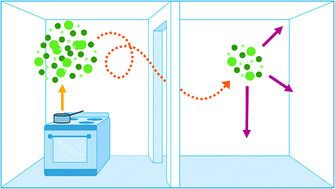Fates and spatial variations of accumulation mode particles in a multi-zone indoor environment during the HOMEChem campaign†
Abstract
Studying the indoor dynamics that impact particles is crucial in order to understand indoor air chemistry and assess overall human exposure to particles. This work investigates spatial gradients in particle concentration, caused by indoor transport and loss mechanisms. We conducted a variety of cooking experiments during the House Observations of Microbial and Environmental Chemistry (HOMEChem) campaign in June 2018 that allowed us to probe these mechanisms. We measured size-resolved (0.06–1 μm and 0.13–3 μm) particle number concentrations from cooking experiments using optical instruments at four locations throughout the house simultaneously. The particle number concentration in the kitchen was 40 ± 10% and 70 ± 10% higher than the concentrations in the living room and the bedroom, respectively. There was a minor size dependence, with larger differences in the smaller sizes of the accumulation mode (0.1–2.5 μm) than the larger end of the range. Dilution accounts for the majority of these concentration differences. Surface deposition was the dominant fate of particles within a zone, with observed deposition velocities ranging from 0.1 to 0.6 m h−1.

- This article is part of the themed collections: Recent Open Access Articles, Best Papers of 2021 from RSC’s Environmental Science journals and Best Papers 2021 - Environmental Science: Processes & Impacts


 Please wait while we load your content...
Please wait while we load your content...